Luoqi Liu
AlignGen: Boosting Personalized Image Generation with Cross-Modality Prior Alignment
May 28, 2025Abstract:Personalized image generation aims to integrate user-provided concepts into text-to-image models, enabling the generation of customized content based on a given prompt. Recent zero-shot approaches, particularly those leveraging diffusion transformers, incorporate reference image information through multi-modal attention mechanism. This integration allows the generated output to be influenced by both the textual prior from the prompt and the visual prior from the reference image. However, we observe that when the prompt and reference image are misaligned, the generated results exhibit a stronger bias toward the textual prior, leading to a significant loss of reference content. To address this issue, we propose AlignGen, a Cross-Modality Prior Alignment mechanism that enhances personalized image generation by: 1) introducing a learnable token to bridge the gap between the textual and visual priors, 2) incorporating a robust training strategy to ensure proper prior alignment, and 3) employing a selective cross-modal attention mask within the multi-modal attention mechanism to further align the priors. Experimental results demonstrate that AlignGen outperforms existing zero-shot methods and even surpasses popular test-time optimization approaches.
GlyphMastero: A Glyph Encoder for High-Fidelity Scene Text Editing
May 08, 2025Abstract:Scene text editing, a subfield of image editing, requires modifying texts in images while preserving style consistency and visual coherence with the surrounding environment. While diffusion-based methods have shown promise in text generation, they still struggle to produce high-quality results. These methods often generate distorted or unrecognizable characters, particularly when dealing with complex characters like Chinese. In such systems, characters are composed of intricate stroke patterns and spatial relationships that must be precisely maintained. We present GlyphMastero, a specialized glyph encoder designed to guide the latent diffusion model for generating texts with stroke-level precision. Our key insight is that existing methods, despite using pretrained OCR models for feature extraction, fail to capture the hierarchical nature of text structures - from individual strokes to stroke-level interactions to overall character-level structure. To address this, our glyph encoder explicitly models and captures the cross-level interactions between local-level individual characters and global-level text lines through our novel glyph attention module. Meanwhile, our model implements a feature pyramid network to fuse the multi-scale OCR backbone features at the global-level. Through these cross-level and multi-scale fusions, we obtain more detailed glyph-aware guidance, enabling precise control over the scene text generation process. Our method achieves an 18.02\% improvement in sentence accuracy over the state-of-the-art multi-lingual scene text editing baseline, while simultaneously reducing the text-region Fr\'echet inception distance by 53.28\%.
DCEdit: Dual-Level Controlled Image Editing via Precisely Localized Semantics
Mar 21, 2025Abstract:This paper presents a novel approach to improving text-guided image editing using diffusion-based models. Text-guided image editing task poses key challenge of precisly locate and edit the target semantic, and previous methods fall shorts in this aspect. Our method introduces a Precise Semantic Localization strategy that leverages visual and textual self-attention to enhance the cross-attention map, which can serve as a regional cues to improve editing performance. Then we propose a Dual-Level Control mechanism for incorporating regional cues at both feature and latent levels, offering fine-grained control for more precise edits. To fully compare our methods with other DiT-based approaches, we construct the RW-800 benchmark, featuring high resolution images, long descriptive texts, real-world images, and a new text editing task. Experimental results on the popular PIE-Bench and RW-800 benchmarks demonstrate the superior performance of our approach in preserving background and providing accurate edits.
Memory Efficient Matting with Adaptive Token Routing
Dec 17, 2024



Abstract:Transformer-based models have recently achieved outstanding performance in image matting. However, their application to high-resolution images remains challenging due to the quadratic complexity of global self-attention. To address this issue, we propose MEMatte, a \textbf{m}emory-\textbf{e}fficient \textbf{m}atting framework for processing high-resolution images. MEMatte incorporates a router before each global attention block, directing informative tokens to the global attention while routing other tokens to a Lightweight Token Refinement Module (LTRM). Specifically, the router employs a local-global strategy to predict the routing probability of each token, and the LTRM utilizes efficient modules to simulate global attention. Additionally, we introduce a Batch-constrained Adaptive Token Routing (BATR) mechanism, which allows each router to dynamically route tokens based on image content and the stages of attention block in the network. Furthermore, we construct an ultra high-resolution image matting dataset, UHR-395, comprising 35,500 training images and 1,000 test images, with an average resolution of $4872\times6017$. This dataset is created by compositing 395 different alpha mattes across 11 categories onto various backgrounds, all with high-quality manual annotation. Extensive experiments demonstrate that MEMatte outperforms existing methods on both high-resolution and real-world datasets, significantly reducing memory usage by approximately 88% and latency by 50% on the Composition-1K benchmark. Our code is available at https://github.com/linyiheng123/MEMatte.
SPDiffusion: Semantic Protection Diffusion for Multi-concept Text-to-image Generation
Sep 02, 2024



Abstract:Recent text-to-image models have achieved remarkable success in generating high-quality images. However, when tasked with multi-concept generation which creates images containing multiple characters or objects, existing methods often suffer from attribute confusion, resulting in severe text-image inconsistency. We found that attribute confusion occurs when a certain region of the latent features attend to multiple or incorrect prompt tokens. In this work, we propose novel Semantic Protection Diffusion (SPDiffusion) to protect the semantics of regions from the influence of irrelevant tokens, eliminating the confusion of non-corresponding attributes. In the SPDiffusion framework, we design a Semantic Protection Mask (SP-Mask) to represent the relevance of the regions and the tokens, and propose a Semantic Protection Cross-Attention (SP-Attn) to shield the influence of irrelevant tokens on specific regions in the generation process. To evaluate our method, we created a diverse multi-concept benchmark, and SPDiffusion achieves state-of-the-art results on this benchmark, proving its effectiveness. Our method can be combined with many other application methods or backbones, such as ControlNet, Story Diffusion, PhotoMaker and PixArt-alpha to enhance their multi-concept capabilities, demonstrating strong compatibility and scalability.
Draw Like an Artist: Complex Scene Generation with Diffusion Model via Composition, Painting, and Retouching
Aug 25, 2024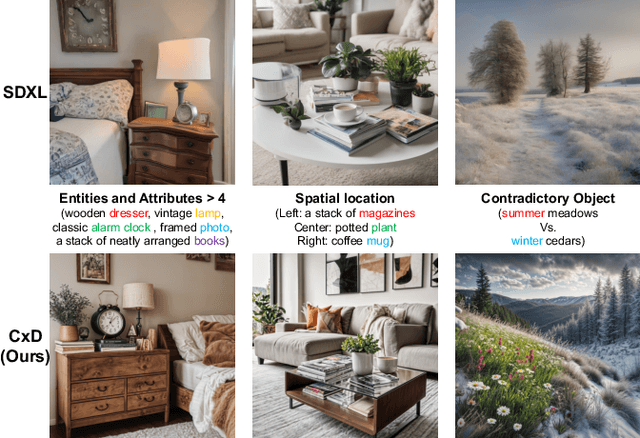
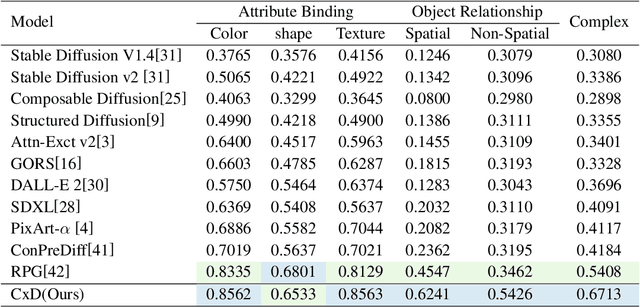
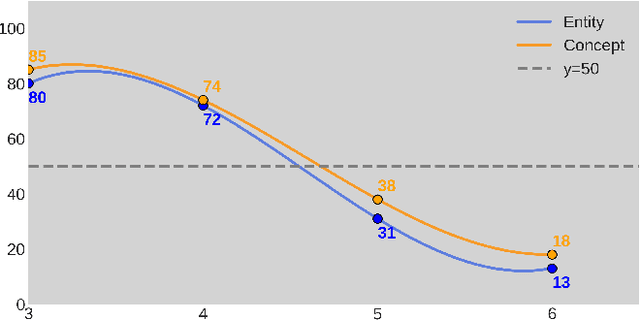
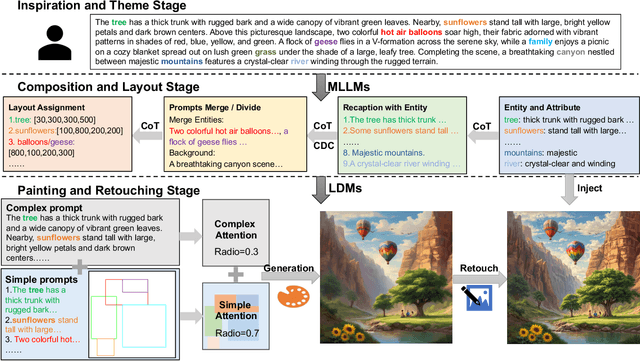
Abstract:Recent advances in text-to-image diffusion models have demonstrated impressive capabilities in image quality. However, complex scene generation remains relatively unexplored, and even the definition of `complex scene' itself remains unclear. In this paper, we address this gap by providing a precise definition of complex scenes and introducing a set of Complex Decomposition Criteria (CDC) based on this definition. Inspired by the artists painting process, we propose a training-free diffusion framework called Complex Diffusion (CxD), which divides the process into three stages: composition, painting, and retouching. Our method leverages the powerful chain-of-thought capabilities of large language models (LLMs) to decompose complex prompts based on CDC and to manage composition and layout. We then develop an attention modulation method that guides simple prompts to specific regions to complete the complex scene painting. Finally, we inject the detailed output of the LLM into a retouching model to enhance the image details, thus implementing the retouching stage. Extensive experiments demonstrate that our method outperforms previous SOTA approaches, significantly improving the generation of high-quality, semantically consistent, and visually diverse images for complex scenes, even with intricate prompts.
SAM-REF: Rethinking Image-Prompt Synergy for Refinement in Segment Anything
Aug 22, 2024



Abstract:The advent of the Segment Anything Model (SAM) marks a significant milestone for interactive segmentation using generalist models. As a late fusion model, SAM extracts image embeddings once and merges them with prompts in later interactions. This strategy limits the models ability to extract detailed information from the prompted target zone. Current specialist models utilize the early fusion strategy that encodes the combination of images and prompts to target the prompted objects, yet repetitive complex computations on the images result in high latency. The key to these issues is efficiently synergizing the images and prompts. We propose SAM-REF, a two-stage refinement framework that fully integrates images and prompts globally and locally while maintaining the accuracy of early fusion and the efficiency of late fusion. The first-stage GlobalDiff Refiner is a lightweight early fusion network that combines the whole image and prompts, focusing on capturing detailed information for the entire object. The second-stage PatchDiff Refiner locates the object detail window according to the mask and prompts, then refines the local details of the object. Experimentally, we demonstrated the high effectiveness and efficiency of our method in tackling complex cases with multiple interactions. Our SAM-REF model outperforms the current state-of-the-art method in most metrics on segmentation quality without compromising efficiency.
Rethinking Video Segmentation with Masked Video Consistency: Did the Model Learn as Intended?
Aug 20, 2024Abstract:Video segmentation aims at partitioning video sequences into meaningful segments based on objects or regions of interest within frames. Current video segmentation models are often derived from image segmentation techniques, which struggle to cope with small-scale or class-imbalanced video datasets. This leads to inconsistent segmentation results across frames. To address these issues, we propose a training strategy Masked Video Consistency, which enhances spatial and temporal feature aggregation. MVC introduces a training strategy that randomly masks image patches, compelling the network to predict the entire semantic segmentation, thus improving contextual information integration. Additionally, we introduce Object Masked Attention (OMA) to optimize the cross-attention mechanism by reducing the impact of irrelevant queries, thereby enhancing temporal modeling capabilities. Our approach, integrated into the latest decoupled universal video segmentation framework, achieves state-of-the-art performance across five datasets for three video segmentation tasks, demonstrating significant improvements over previous methods without increasing model parameters.
PVUW 2024 Challenge on Complex Video Understanding: Methods and Results
Jun 24, 2024



Abstract:Pixel-level Video Understanding in the Wild Challenge (PVUW) focus on complex video understanding. In this CVPR 2024 workshop, we add two new tracks, Complex Video Object Segmentation Track based on MOSE dataset and Motion Expression guided Video Segmentation track based on MeViS dataset. In the two new tracks, we provide additional videos and annotations that feature challenging elements, such as the disappearance and reappearance of objects, inconspicuous small objects, heavy occlusions, and crowded environments in MOSE. Moreover, we provide a new motion expression guided video segmentation dataset MeViS to study the natural language-guided video understanding in complex environments. These new videos, sentences, and annotations enable us to foster the development of a more comprehensive and robust pixel-level understanding of video scenes in complex environments and realistic scenarios. The MOSE challenge had 140 registered teams in total, 65 teams participated the validation phase and 12 teams made valid submissions in the final challenge phase. The MeViS challenge had 225 registered teams in total, 50 teams participated the validation phase and 5 teams made valid submissions in the final challenge phase.
2nd Place Solution for MOSE Track in CVPR 2024 PVUW workshop: Complex Video Object Segmentation
Jun 12, 2024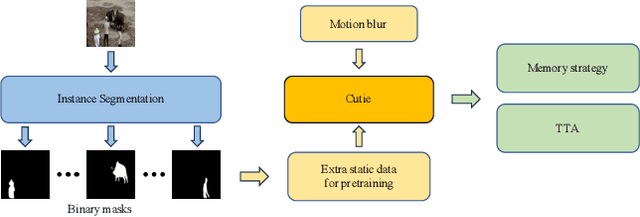
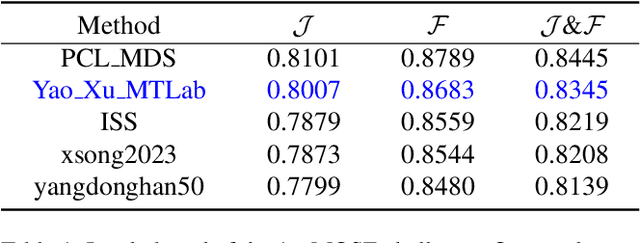
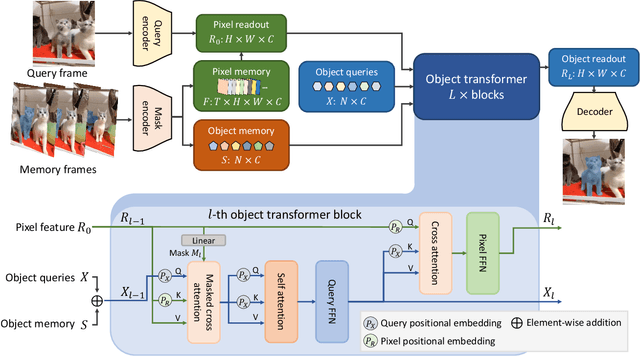

Abstract:Complex video object segmentation serves as a fundamental task for a wide range of downstream applications such as video editing and automatic data annotation. Here we present the 2nd place solution in the MOSE track of PVUW 2024. To mitigate problems caused by tiny objects, similar objects and fast movements in MOSE. We use instance segmentation to generate extra pretraining data from the valid and test set of MOSE. The segmented instances are combined with objects extracted from COCO to augment the training data and enhance semantic representation of the baseline model. Besides, motion blur is added during training to increase robustness against image blur induced by motion. Finally, we apply test time augmentation (TTA) and memory strategy to the inference stage. Our method ranked 2nd in the MOSE track of PVUW 2024, with a $\mathcal{J}$ of 0.8007, a $\mathcal{F}$ of 0.8683 and a $\mathcal{J}$\&$\mathcal{F}$ of 0.8345.
 Add to Chrome
Add to Chrome Add to Firefox
Add to Firefox Add to Edge
Add to Edge